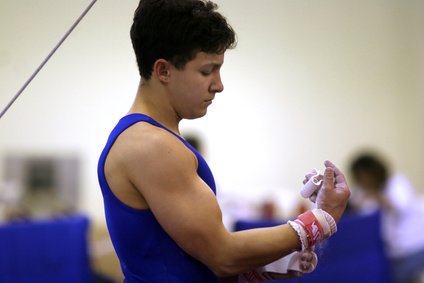
Without doubt, technical ability and preparation is paramount in gymnastics training.
However, technique can only be applied within the boundaries of physical fitness – be it strength, power or anaerobic capacity. By developing a sport-specific base of strength, power and flexibility, proper technique can be coached and acquired more easily.
The physiological demands of gymnastic events places a heavy burden on anaerobic energy pathways (1). While energy contributions will differ between different apparatus, this means that strength and power are more important to a gymnast than aerobic endurance (2).
Unfortunately, strength training in sport is often misunderstood. Bodybuilding and weight training purely for aesthetic purposes bears little resemblance to strength training for gymnastics. In fact, the wrong type of strength training can actually be detrimental to performance (3). Bodybuilders train muscle groups – athletes must train movements. This is especially true for gymnasts who usually perform movements that require every major muscle group in the body to work in synergy.
Performing more gymnastics does not guarantee even a minimum level of strength to perform the skill correctly (4). Instead conditioning is required so that the athlete can learn the skill correctly the first time. Re-learning a skill can be time consuming, frustrating and inefficient. Of course the principle of specificity still holds true and conditioning should match the movement patterns of the events as closely as possible.
The articles below cover various aspects of gymnastics training. Coaches across a range of sports are interested in gymnastics training for their own athletes, and while caution is needed in this area, many of the drills and technique are cross-transferable.
Gymnastics Training Articles
Body Fat Percentage – An Overview
What is an “ideal” body fat percent and what are typical values seen in gymnasts?
Calculating Body Composition
If you have your body fat percentage measured chances are one of these 6 methods will be used. Which are the best… and the worst?
Flexibility training section
Complete guide to flexibility training including the various types of stretching, sample exercises and the physiology behind how range of movement increases
Static Stretching Exercises and Flexibility Training Program
Static stretching exercises are best performed when your body is completely warmed up – often at the end of a training session to increase range of motion. Avoid static stretching immediately before gymnastics competition
Dynamic Stretches & Stretching Routine
Use these dynamic stretches as part of your warm up routine. Dynamic stretching has been shown to decrease muscle tightness, which may be associated to an increased risk of muscles and tendon tears…
How To Design Resistance Training Programs For Athletes
Strength training has become an essential component in a gymnastics training program. Gymnasts train tirelessly to perfect their skill and technique. But technique can only be applied within the limits of an athletes strength, making its development equally important
Power Training for Athletes
Strength and power are not the same. Do gymnasts need to be powerful? Yes. Learn how you can convert a solid strength base into explosive power on the field…
Plyometric Training for Developing Explosive Power
Plyometrics is used in many sports as an effective way to increase speed of movement and power. Gymnasts can benefit from both upper and lower body plyometric exercises…
Isometric Exercises and Gymnastics training
Gymnastics is one of the few sports that requires static strength. These isometric exercises can be performed with little or no equipment…
Core Strength Conditioning For Athletes
The muscles of the core region act as a link between the upper and lower body. The stronger and more ale they are, the greater the synergy of movement can be. Core strength is essential for gymnasts
Medicine Ball Exercises
Medcine balls can be used to develop strength and power and allow the gymnast to incorporate very specific movements into his or her routine…
Product Reviews
Best Pull Up Bar
Looking to practise at home? A pull-up bar makes it easy.
References
1) Lange B, Halkin AS, Bury T. Lange B, Halkin AS, Bury T. Rev Med Liege. 2005 Dec;60(12):939-4.
2) Jemni M, Friemel F, Sands W, Mikesky A. Evolution of the physiological profile of gymnasts over the past 40 years. A review of the literature. Can J Appl Physiol. 2001 Oct;26(5):442-56
3) James J. Major. Strength Training Fundamentals in Gymnastics Conditioning. Technique. 1996, Vol. 16, No. 8
4) Plotkin, A.B., Rubin, V.S., Arkeev, L.J. Exercises with weights in specific conditioning of elite gymnasts. Gymnastika. 1983. 1, 21-23

Jacky has a degree in Sports Science and is a Certified Sports and Conditioning Coach. He has also worked with clients around the world as a personal trainer.
He has been fortunate enough to work with a wide range of people from very different ends of the fitness spectrum. Through promoting positive health changes with diet and exercise, he has helped patients recover from aging-related and other otherwise debilitating diseases.
He spends most of his time these days writing fitness-related content of some form or another. He still likes to work with people on a one-to-one basis – he just doesn’t get up at 5am to see clients anymore.